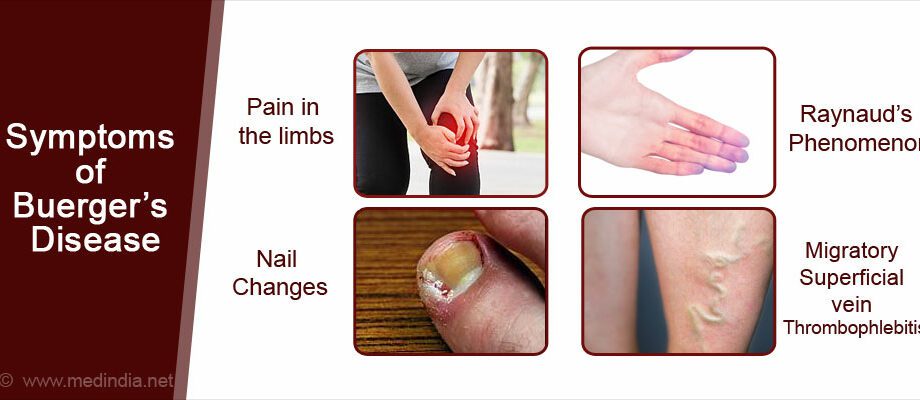Contents
Buerger’s disease: definition, causes and treatments
Buerger’s disease, or thromboangiitis obliterans, is an occlusive and segmental inflammation of the arteries and veins in the legs or arms. It is seen almost exclusively in male smokers between the ages of 20 and 40. Symptoms indicate a decrease in blood flow to one extremity: coldness, numbness, tingling, burning sensations, with the consequences: limping, non-healing ulcers of the feet, resting pains, even gangrene. There is currently no specific treatment for Buerger’s disease. Stopping smoking is the most important part of treatment. The prognosis is excellent when smoking cessation is achieved, but when smoking is continued the disease inevitably progresses, often requiring amputation. Sometimes medication is necessary.
What is Buerger’s disease?
Also called thromboangiitis obliterans, Buerger’s disease is a rare and severe disease that occurs as a result of segmental and inflammatory obliteration of small and medium arteries, as well as the veins of the lower and upper extremities. It is characterized by thrombosis (clot) and recanalization of the affected vessels. The arteries that supply blood to organs are the site of inflammation, which decreases the volume of blood that reaches the organs. It is mainly the arteries of the forearms and legs, below the elbows and knees, that are affected.
Buerger’s disease is present all over the world. While in Europe, it represents less than 5% of all arterial disease of the lower limbs and 3% of peripheral arterial occlusions, in Asia and India, it represents more than 50% of arterial disease.
Buerger’s disease develops gradually in smokers and affects men under 9 years of age 10 times out of 40. Considered a predominantly male disease, it is becoming more and more common in women who smoke. It is more common in subjects carrying the HLA-A9 and HLA-B5 (human leukocyte antigen) genotypes.
On the social and professional level, Buerger’s disease can have consequences on employment, given the repetition of hospitalizations and the handicap engendered when it continues to evolve.
What are the causes of Buerger’s disease?
The link between smoking and thromboangiitis obliterans is poorly understood, as are the causes of the disease. However, the role of tobacco (consumption or exposure) is preponderant in the onset and clinical worsening of the disease.
It seems that smoking causes inflammation and narrowing of the arteries. However, few smokers develop thromboangiitis obliterans. Some people are more susceptible than others for reasons as yet unknown. Nevertheless, thromboangiitis obliterans inexorably worsens in chronic smokers and frequently results in amputation. On the contrary, if the person with thromboangiitis obliterans stops smoking, amputation is rarely necessary.
What are the symptoms of Buerger’s disease?
Usually, symptoms that occur as a result of reduced blood supply appear gradually. These include:
- sensations of cold;
- numbness;
- tingling or burning sensations;
- pains.
These abnormal sensations start at the fingertips or toes and move up the legs or arms. The legs are more frequently affected than the arms. Cramps occur in the muscles of the calf or feet if the legs are affected, and in the hands or forearms if the arms are affected. As the disease progresses, the cramps become more painful and last longer.
In the upper limbs, the blood not reaching the fingers in sufficient quantity, the patient presents:
- cold hands, white or blue, signs favored by exposure to cold. This is Raynaud’s phenomenon;
- wounds of the fingertips which are sometimes difficult to heal and especially very painful, when the arterial vascular lesions are too important.
The progressive risk is the amputation of one or more fingers.
In the lower limbs, the feet are the first to be poorly supplied with blood. The signs of the disease do not progress, and patients often have pain in the soles of the feet immediately upon walking. We talk about intermittent claudication. The importance of arterial lesions makes the skin of the feet very fragile, which can rupture at the slightest trauma. The consequence is the development of ulcerations, that is to say lesions, of the toes which can be accompanied by secondary infections or even amputation of the toes, the foot or even the leg.
Some people with Buerger’s disease also have episodes of inflammation of the veins or migratory phlebitis, usually in the superficial veins, which can affect the foot, ankle, leg or upper limbs.
Rheumatologic manifestations may occur with inflammatory arthralgia which may precede vascular symptomatology.
How to treat Buerger’s disease?
Smoking cessation
There is currently no specific treatment for Buerger’s disease. The management of Buerger’s disease involves stopping smoking, the continuation or resumption of which inevitably leads to an immediate worsening of the disease, often requiring amputation. Many solutions exist today to help quit smoking. Cannabis, which is also the cause of manifestations of Buerger’s disease, should also be banned.
In case of insufficient blood circulation with risk of amputation
The use of strong vasodilators such as iloprost (Ilomedine) infusion during hospitalization for several days can help relieve pain and prevent amputation.
Surgery, especially a sympathectomy, may be done to resect some adjacent nerves and prevent constriction of blood vessels. However, these interventions are rarely performed as they generally only improve blood flow temporarily.
In all cases, psychological support is necessary to promote smoking cessation, help endure pain and sometimes amputation of a finger or toe.
Complementary measures
It is recommended to avoid:
- exposure to cold, which causes narrowing of blood vessels;
- taking certain medicines which cause the blood vessels to constrict such as ephedrine, pseudoephedrine or phenylephrine, which are components of some remedies used for sinus congestion and the common cold;
- taking medicines that promote clotting such as estrogen in birth control pills or hormone replacement therapy (HRT)
- thermal and chemical injuries;
- minor surgical procedures such as callus removal. Corns and calluses should be treated by a podiatrist;
- mechanical injuries, especially those due to poorly fitting shoes. Comfortable and wide shoes will prevent trauma to the foot.










